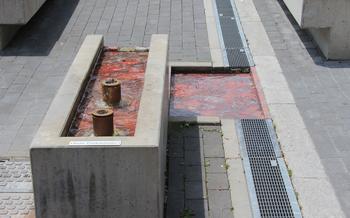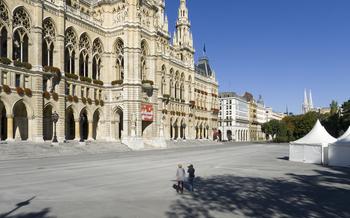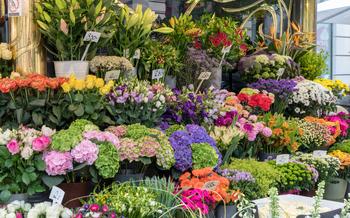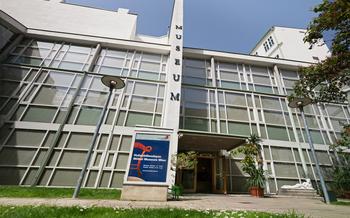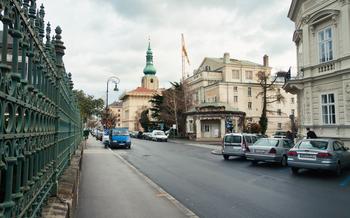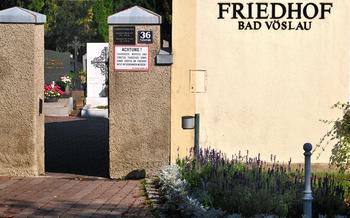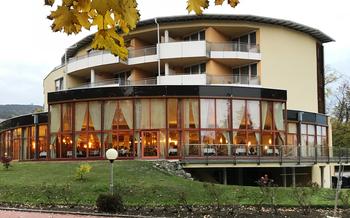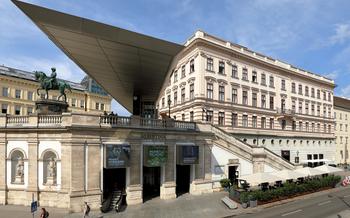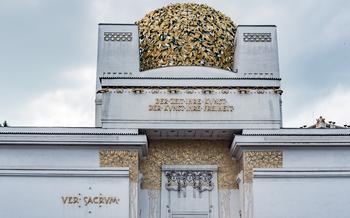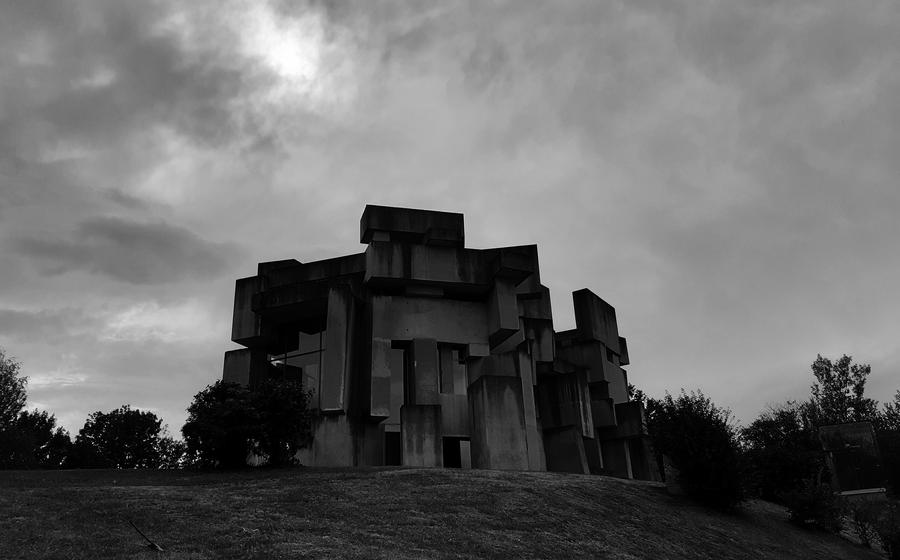
Wotruba Church
- Wotruba Church: A Unique Symbol of Modernist Architecture
- Location and Accessibility
- Hours of Operation and Admission Fees:
- Guided Tours and Audio Guides
- Exploring the Exterior
- Stepping Inside the Church
- Admiring the Wotruba Sculptures
- Attending Mass and Services
- Suggested Itinerary for a Visit
- Photography Tips
- Historical Significance and Context
- Nearby Attractions and Recommendations
- Practical Tips for Visitors
Wotruba Church: A Unique Symbol of Modernist Architecture
Nestled in the tranquil surroundings of Vienna's 23rd district, the Wotruba Church stands as a testament to the innovative spirit of modernist architecture. Conceived by the renowned Austrian sculptor Fritz Wotruba, this remarkable edifice is not merely a place of worship but a work of art that has indelibly shaped Vienna's architectural landscape. Constructed between 1974 and 1976, the church emerged as a bold departure from traditional ecclesiastical designs, embodying Wotruba's unique artistic vision and challenging prevailing notions of religious architecture. Its striking exterior, composed of 152 concrete blocks arranged in a seemingly chaotic yet harmonious manner, evokes a sense of awe and intrigue, inviting visitors to contemplate the interplay of form and spirituality.
Location and Accessibility
The Wotruba Church stands prominently in the Viennese district of Mauer, located at Ruckergasse 1-3, 1230 Wien, Austria. Reaching the church is straightforward, with various transportation options available.
Public Transportation:
-
Take the U3 subway line and alight at Ottakring station. From there, catch bus 48A and get off at "Wotrubakirche" stop.
-
Alternatively, board tram line 46 or 49 and disembark at "Wotrubakirche" stop.
Driving and Parking:
- For those driving, navigate to the church's address and utilize the available parking spaces nearby. Street parking is generally free in the area.
Guided Tours:
- Guided tours of the church are offered periodically, providing a deeper insight into its history and significance. Check the church's official website for tour schedules and reservations.
Hours of Operation and Admission Fees:
The Wotruba Church welcomes visitors with open arms, inviting them to explore its unique architectural beauty and spiritual significance. To ensure a seamless visit, it's essential to be aware of its operating hours and admission fees.
The church's doors are open to the public from Tuesday to Sunday, with varying hours throughout the week. During the summer months (April to October), visitors can immerse themselves in its splendor from 10:00 am to 6:00 pm, while in the winter months (November to March), the hours are slightly shorter, from 10:00 am to 4:00 pm. It's always advisable to check the official website or contact the church directly for any updates or special considerations.
Admission to the Wotruba Church is free of charge, allowing everyone to experience its architectural and spiritual wonders without any financial barriers. This open-door policy reflects the church's commitment to inclusivity and accessibility, ensuring that visitors from all backgrounds can appreciate its beauty and significance.
While admission is free, donations are gratefully accepted to support the ongoing maintenance and preservation of this architectural masterpiece. Contributions from visitors help ensure that future generations can continue to marvel at the Wotruba Church's unique charm and enduring legacy.
Guided Tours and Audio Guides
For a deeper understanding of the Wotruba Church's history, architecture, and significance, consider joining a guided tour. Knowledgeable guides provide insights into the church's design, Wotruba's artistic vision, and the cultural and religious context in which it was created. Tours typically last for about an hour and are offered in various languages. Pre-booking is recommended to secure your spot, especially during peak tourist season.
If you prefer a self-guided exploration, audio guides are available for rent at the church entrance. These guides offer a detailed commentary on the church's architecture, sculptures, and history, allowing you to learn at your own pace. Additionally, smartphone apps with interactive guides and augmented reality features are available for download, providing a modern and immersive way to explore the church.
Exploring the Exterior
The exterior of the Wotruba Church is a captivating sight, featuring a unique design that sets it apart from traditional ecclesiastical architecture. Its most striking feature is the series of monumental sculptures that adorn the facade and roof of the church. These sculptures, created by Wotruba himself, are abstract and geometric in form, resembling blocks or monoliths. Their placement and arrangement create a dynamic interplay of light and shadow, adding depth and texture to the church's exterior.
Visitors can take a leisurely stroll around the church to admire the sculptures from various angles. Each sculpture is unique and carries its own symbolic meaning, inviting viewers to contemplate their significance. Some sculptures represent human figures, while others resemble abstract forms or architectural elements. Together, they form a cohesive ensemble that reflects Wotruba's artistic vision and his exploration of the relationship between architecture and sculpture.
Photographers will find the exterior of the Wotruba Church to be a treasure trove of opportunities. The stark contrast between the white concrete sculptures and the blue sky creates a visually striking composition. The interplay of light and shadow throughout the day offers photographers a variety of lighting conditions to capture the church's essence. Patience and experimentation will reward photographers with stunning images that capture the unique beauty and sculptural richness of the Wotruba Church.
Stepping Inside the Church
As you enter the Wotruba Church, a palpable sense of serenity and contemplation washes over you. The interior, adorned with natural light filtering through the intricate concrete latticework, exudes an almost ethereal atmosphere. Your eyes are immediately drawn to the soaring concrete columns, their rough-hewn surfaces contrasting with the smoothness of the polished concrete floor. The interplay of light and shadow creates a dynamic visual experience, as the sun's rays dance and play off the textured walls, casting ever-shifting patterns that seem to bring the church to life.
The sparse interior design is devoid of any traditional religious iconography, allowing the architectural elements themselves to take center stage. The focus here is on the raw beauty of the concrete, its inherent strength and solidity conveying a sense of permanence and stability. The absence of pews or seating encourages visitors to move freely throughout the space, to wander and explore, to find their own quiet corner for contemplation or prayer.
Admiring the Wotruba Sculptures
Fritz Wotruba's sculptures, which are strategically placed throughout the church's interior and exterior, are undoubtedly one of the church's highlights. These enigmatic works of art, carved from hard stone, are a testament to Wotruba's unique style and artistic vision. His sculptures, often abstract and geometric in form, convey a sense of monumentality and emotional depth that resonates with viewers.
Wotruba's sculptures are not merely decorative elements; they hold profound symbolic and spiritual significance. Each sculpture, with its distinct shapes and textures, represents a different aspect of human existence, from joy and suffering to faith and doubt. By carefully positioning these sculptures within the church's architecture, Wotruba created a powerful dialogue between art and spirituality, inviting viewers to contemplate the deeper meanings of life.
Take some time to study the sculptures closely, observing their intricate details and the interplay of light and shadow that animates them. Allow yourself to be drawn into their emotional and spiritual depths, letting them provoke contemplation and reflection. Wotruba's sculptures are not just works of art; they are portals into the human condition, inviting us to explore our own emotions, beliefs, and aspirations.
Attending Mass and Services
The Wotruba Church is not only an architectural masterpiece but also a functioning place of worship. Attending a mass or service here offers a unique opportunity to experience the spiritual and communal atmosphere within this remarkable space. The church regularly hosts religious services, including Sunday masses, weekday masses, and special events like concerts or exhibitions.
Before attending a service, it's essential to familiarize yourself with the church's etiquette and dress code. While there is no strict dress code, visitors are encouraged to dress respectfully, avoiding shorts, tank tops, or revealing clothing. During mass, it's customary to stand during the Gospel reading and kneel during the Eucharistic Prayer.
Once inside the church, take a moment to soak in the serene and contemplative atmosphere. The interplay of light and shadow, the simplicity of the interior design, and the absence of traditional religious iconography create a unique and powerful spiritual experience. The church's acoustics are also exceptional, making it an ideal venue for concerts and musical performances.
Attending a service at the Wotruba Church is a chance to connect with the local community and share in their religious traditions. It's an opportunity to reflect on your spiritual journey and find solace and inspiration within this sacred space.
Suggested Itinerary for a Visit
To make the most of your visit to the Wotruba Church, plan to spend at least an hour exploring its exterior and interior. Take your time to admire the unique architecture, sculptures, and serene atmosphere. If you're interested in delving deeper into the history and significance of the church, consider joining a guided tour. Tours typically last around 45 minutes and provide valuable insights into Wotruba's artistic vision and the church's cultural and religious importance.
After exploring the church, take a leisurely stroll through the surrounding park. Find a bench to sit and contemplate the beauty of the church from a distance. If you're visiting during the warmer months, you can even pack a picnic lunch to enjoy in the park.
To enhance your visit, combine it with other nearby attractions. The Wotruba Church is located in the Liesing district of Vienna, which is home to several other cultural and historical sites. The Lainzer Tiergarten, a vast forested area, is just a short walk away and offers opportunities for hiking, biking, and wildlife watching. The Hermesvilla, a former imperial hunting lodge, is also nearby and worth a visit for its stunning architecture and gardens.
By combining the Wotruba Church with other attractions in the area, you can create a fulfilling and memorable day trip in Vienna.
Photography Tips
Capturing the essence of the Wotruba Church through photography is a rewarding experience. To make the most of your photographic journey, consider these tips:
-
Embrace Natural Lighting: The Wotruba Church's unique design plays with light and shadow, creating dramatic effects. Visit during the golden hours of sunrise or sunset to capture the church's exterior bathed in warm, diffused light.
-
Experiment with Angles: Don't limit yourself to frontal shots. Walk around the church, exploring different perspectives. Experiment with low angles to accentuate the sculptures' imposing presence or high angles to capture the interplay of light and shadow on the facade.
-
Focus on Details: While the church's overall form is striking, don't overlook the intricate details. Zoom in on the sculptures to capture their expressive faces and textures. Look for interesting patterns and compositions within the architecture.
-
Capture the Essence: Beyond technical considerations, strive to capture the emotional and spiritual essence of the church. Convey the sense of awe, serenity, or contemplation you experience as you explore this unique architectural masterpiece.
Historical Significance and Context
The Wotruba Church stands as a significant landmark in Viennese history and architecture, embodying a unique chapter in the city's cultural and religious evolution. Its construction was met with both admiration and controversy, sparking debates about the role of modern architecture in a city steeped in tradition.
Despite the initial resistance, the church eventually gained recognition as a groundbreaking masterpiece, earning its place as a protected cultural monument. Today, it serves as a testament to the transformative power of art and architecture, while also offering a glimpse into the complex social and cultural dynamics of Vienna in the mid-20th century.
Nearby Attractions and Recommendations
A visit to the Wotruba Church can be conveniently combined with several other attractions in the vicinity. Just a short walk away, you'll find the exquisite Augarten Park, a sprawling green oasis with meticulously manicured gardens, rose gardens, and a butterfly house. Take a leisurely stroll along its picturesque paths and enjoy the serene atmosphere.
For art enthusiasts, the Museum Moderner Kunst (MUMOK), located nearby, is a must-visit. This contemporary art museum houses an impressive collection of modern and contemporary art, including works by Andy Warhol, Pablo Picasso, and Joseph Beuys.
If you're interested in exploring the surrounding area further, consider visiting the Heurigenviertel, a charming district known for its traditional wine taverns, or Heurigen. Sample local wines and indulge in delicious Austrian cuisine while immersing yourself in the local culture.
To make the most of your visit, consider purchasing the Vienna Pass, which provides free or discounted admission to over 70 attractions, including the Wotruba Church, as well as unlimited use of public transportation.
Practical Tips for Visitors
For a seamless and enjoyable visit, consider these practical tips:
-
Accessibility: The Wotruba Church is wheelchair accessible, with ramps and elevators ensuring easy navigation throughout the building. Accessible restrooms are also available on the premises.
-
Restrooms: Public restrooms are located within the church, near the main entrance. They are well-maintained and accessible during regular opening hours.
-
Safety Precautions: While the church is generally safe, visitors are advised to be mindful of their belongings, especially during crowded events or services. Follow any instructions or guidelines provided by the church staff to ensure a safe and respectful experience.
